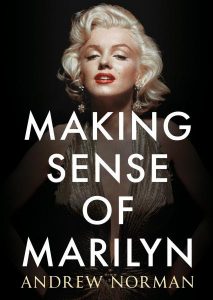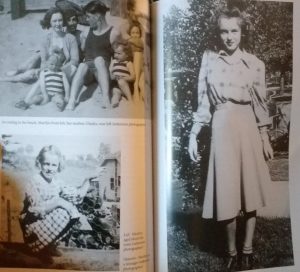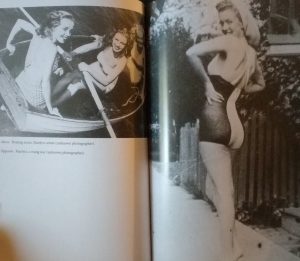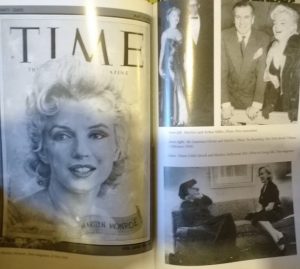 How do you solve a problem like Norma Jeane, when even her name is in doubt? More than a thousand books to date have been devoted to this question. As Ezra Goodman, at the height of her fame, wrote so prophetically: “The riddle that is Marilyn Monroe has not been solved.” Andrew Norman’s Making Sense of Marilyn is the latest attempt. With a background in medicine, Dr Norman is now a prolific biographer. Marilyn would surely be proud, if rather surprised, to find herself among a litany of subjects as lofty and diverse as Jane Austen and Winston Churchill.
How do you solve a problem like Norma Jeane, when even her name is in doubt? More than a thousand books to date have been devoted to this question. As Ezra Goodman, at the height of her fame, wrote so prophetically: “The riddle that is Marilyn Monroe has not been solved.” Andrew Norman’s Making Sense of Marilyn is the latest attempt. With a background in medicine, Dr Norman is now a prolific biographer. Marilyn would surely be proud, if rather surprised, to find herself among a litany of subjects as lofty and diverse as Jane Austen and Winston Churchill.
The difficulty of understanding who Marilyn really was, Norman believes, is compounded by unreliable sources. Her 1954 memoir, My Story, was ghost-written with Marilyn’s co-operation before being shelved at her request, and later revised for posthumous publication. But the confusion had begun when she was a child, and her troubled mother Gladys, whether deliberately or by mistake, told her that her estranged father had died in a car accident. “In her early years [Marilyn] was insecure and introspective,” Norman observes, “and unable even to make sense of herself.” As a starlet, she followed the studio’s Cinderella narrative and claimed she was an orphan. This was done partly for publicity, but also to protect living relatives. Unfortunately, these fabrications also hurt others close to her, like foster carer Ida Bolender, with whom she had lived until she was seven years old.
Norman relies mainly on primary sources, including accounts from Marilyn’s first husband, Jim Dougherty; her half-sister, Bernice Miracle; actress Susan Strasberg; and photographer George Barris, described as her ‘confidante.’ In the months before she died, Marilyn worked on a magazine shoot with Barris. He also interviewed her extensively for a book project, which was finally published many years later. However, the details of Barris’ arrangement with Marilyn are even hazier than the origins of My Story. And while she does seem to have put her trust in Barris, he had only met her once before their collaboration.
“When a little girl feels lonely and that no one cares or wants her,” Marilyn told Barris, “it’s just something that she can never forget as long as she lives.” In 1935, she went to live with her mother for the first time. Gladys worked as a film cutter in Hollywood and had put down a deposit on a new home. But after a few happy months, her mental health rapidly declined. She suffered a nervous breakdown and was committed to a psychiatric hospital. A family friend, Grace Goddard, took over Marilyn’s care but this did not prevent her from being shunted between foster homes and an orphanage. As no one was willing to tell the truth about her mother’s illness, for several years the young girl was unsure whether Gladys was still living.
 Compounding her sense of abandonment was the spectre of sexual abuse. Returning to My Story, Norman considers her experience of being molested by a boarder in a foster home. The account is deliberately vague, with some details probably altered. Jim Dougherty dismissed the claim that she had been raped, on the grounds that she was still a virgin when they married. But this does not preclude other forms of abuse.
Compounding her sense of abandonment was the spectre of sexual abuse. Returning to My Story, Norman considers her experience of being molested by a boarder in a foster home. The account is deliberately vague, with some details probably altered. Jim Dougherty dismissed the claim that she had been raped, on the grounds that she was still a virgin when they married. But this does not preclude other forms of abuse.
Her first marriage, at sixteen, was arranged when Grace, her legal guardian, moved to another state. Marilyn had been dating Jim, a neighbour and five years her senior, for several months. “It wasn’t fair to push me into marriage,” she told Barris, admitting she was “scared to death about what a husband would do to me.” According to Jim, the marriage was happy at first, but his decision to enlist in the Merchant Marine triggered his wife’s fears of rejection. While he was serving overseas she began working as a model, and the marriage collapsed.
While her early film career was arduous, she surrounded herself with creative mentors who encouraged her ambitions. Her perceptive analysis of the characters she played belied their essential shallowness. She would describe Angela in The Asphalt Jungle as a “rich man’s darling”; All About Eve’s Miss Caswell as an “untalented showgirl”; in Monkey Business she was Miss Laurel, a “slightly dumb secretary”; and as Rose in Niagara, an “amoral type.” Her fragile identity was often at odds with her public image as a sex symbol, and fame only intensified this conflict.
Even with lesser material, Marilyn gave her all to each role: and when stardom was hers, she shone like no other. None of her inner turmoil is evident in The Seven Year Itch, made while her brief marriage to Joe DiMaggio was falling apart. “Marilyn enters into the spirit of the film,” Norman remarks, “proving once again that comedy was her forte.” In 1955 she moved to New York, and committed herself to method acting and psychoanalysis – a dual process that could be, as Norman comments, “equally painful and distasteful.” Bernice Miracle felt that Marilyn had lost confidence in herself, but her career continued to soar.
Her third husband, playwright Arthur Miller, found her next performance, in Bus Stop (1956), “deeply moving.” But filming of The Prince and the Showgirl led to clashes with her co-star and director, Sir Laurence Olivier. Norman believes that “the film is made bearable only by Marilyn’s gaiety.” The Miller marriage was overshadowed by Arthur’s legal battle with the House Un-American Activities Committee, which he finally won with Marilyn’s loyal support. “Instead of showing anger at the way her husband had been treated,” Norman remarks on her public demeanour, “she was the epitome of dignity and charm.”
 Behind the scenes, Miller was alarmed by her psychological dependence on acting coaches Lee and Paula Strasberg, and her growing addiction to sleeping pills. Watching Marilyn perform ‘I’m Through With Love’ in Some Like It Hot, Norman observes that she looked “genuinely sad.” Curtice Taylor, whose father Frank produced The Misfits, considered her a “natural actress,” but this deeply personal project (written for her by Miller) would mark the end of her longest relationship.
Behind the scenes, Miller was alarmed by her psychological dependence on acting coaches Lee and Paula Strasberg, and her growing addiction to sleeping pills. Watching Marilyn perform ‘I’m Through With Love’ in Some Like It Hot, Norman observes that she looked “genuinely sad.” Curtice Taylor, whose father Frank produced The Misfits, considered her a “natural actress,” but this deeply personal project (written for her by Miller) would mark the end of her longest relationship.
Miller’s controversial 1964 play, After the Fall, depicts the doomed marriage of a suicidal star and her guilt-ridden husband, and Norman believes it holds the key to Marilyn’s troubled psyche (and why Miller was unable to save her.) Following their divorce, she moved back to Los Angeles and grew close again to DiMaggio, whom Bernice described as “full of common sense and concern.”
Norman briefly mentions George Barris’ claim that she was in a “serious romance” with John F. Kennedy, but seems reluctant to pursue it further. It is doubtful that Barris had any direct knowledge of the alleged affair. Nonetheless, Norman argues that she looked “pinched and drawn” during her iconic performance of ‘Happy Birthday Mr. President’ at Madison Square Garden in May 1962. By June, she had been fired from her unfinished comedy, Something’s Got to Give, due to repeated absences from the set.
In the weeks before her fatal overdose in August, Marilyn was seeing her psychiatrist Dr Ralph Greenson almost daily. Her physician, Dr Hyman Engleberg, was trying to wean her off barbiturates, but also prescribing Chloral Hydrate. At times Marilyn’s speech was slurred, and she became drowsy and uncoordinated – a side-effect of the drugs she was taking. Miller had noted during their marriage how she seemed oblivious to the physical ravages of her habit, while Norman argues that barbiturate abuse may have exacerbated her recurrent depression.
There was a documented history of mental illness in Marilyn’s family, and her mother Gladys was diagnosed a paranoid schizophrenic. While some biographers now speculate that Marilyn may have suffered from Bipolar Disorder, Norman explores the alternate possibility of Borderline Personality Disorder (BPD.) This condition generally manifests in early adulthood, and is so-named because it sits on the borderline between neurosis and psychosis. Its defining features include unstable self-image; feelings of emptiness; fear of abandonment; bouts of anxiety, and impulsivity; instability in relationships; severe dissociative feelings; and recurrent suicidal behaviour.
“Marilyn was a gifted, caring and intelligent person, with deep sensitivity and a poetic soul,” Norman writes, noting that “creativity is so often forged in the crucible of pain.” No matter how high she climbed on the ladder of success, insecurities constantly dragged her down and she needed close supervision to keep her from self-harm. In Making Sense of Marilyn, Andrew Norman refers frequently to Monroe’s own words, recorded in interviews and her own journals and poetry.
Over a concise 160 pages, and with a selection of photographs, the author cites his sources fully. Setting aside a few minor factual errors, this is a finely drawn portrait of a remarkable woman who wanted most of all to be loved. And as Dr. Norman concludes, “this yearning, and her vulnerability, captivated the world.”
– Tara Hanks for IM






